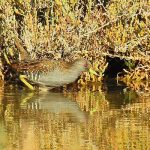AUSTRALIAN SPOTTED CRAKE
Endemic to Australia the Australian spotted crake is typically found in freshwater marshes, swamps, and the margins of lakes and rivers throughout Southeast and Western Australia. It is less common in Tasmania and tropical areas of northern Australia. They prefer areas with dense vegetation, such as reeds and rushes, which provide both food and cover from predators. These wetlands are often teeming with life, creating a rich tapestry of sounds and sights.
In the wild, the lifespan of the Australian spotted crake is not extensively documented, but like many small birds, they likely live for several years, with some individuals potentially reaching up to 5 years or more under favourable conditions.
These crakes are omnivorous, with a diet that reflects the abundance of their wetland habitats. They forage for insects, small invertebrates, and aquatic plants. Picture them delicately probing the mud with their slender bills, searching for tiny morsels. They may also feed on seeds and small fish, showcasing their adaptability and resourcefulness.
Breeding season for the Australian spotted crake usually occurs from August to December, coinciding with the Australian spring and summer. During this time, males perform elaborate displays to attract females, including vocalisations and physical posturing. They build their nests in dense vegetation, often close to water. The nests are well-hidden, crafted from reeds and grasses.
The female typically lays 5 to 7 eggs, which are incubated by both parents. After about three weeks, the eggs hatch, revealing tiny, downy chicks. Both parents are involved in feeding and protecting their young, guiding them through the intricate maze of the wetland.
Like many wetland species, they face threats from habitat loss, pollution, and climate change. Wetland conservation efforts are crucial to ensure these birds continue to thrive in their natural habitats.

